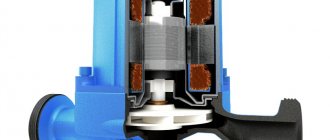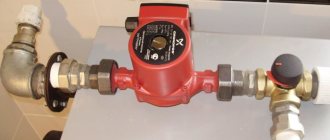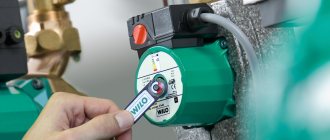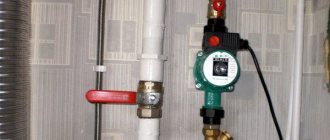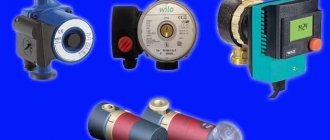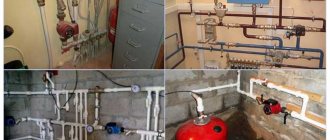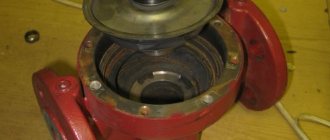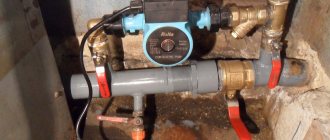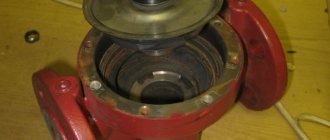The material was prepared with the participation of experts from Wilo .
The past winter heating period with severe frosts, sudden thaws and frequent transitions through 0 could reveal all the pros and cons in the operation of the heating system of a country house. As a result, depending on the efficiency of the equipment, homeowners either spent the planned funds on heating the cottage, or overpaid and thought about how to reduce costs in the next heating season.
There are several ways to modernize your heating system and thereby reduce operating costs in the long term. One of them is to equip the “engineer” with a circulation pump that flexibly adapts to constantly changing operating conditions. We are looking into the issue with the help of an engineer from a circulation pump manufacturer.
- What are the features of a modern heating system?
- Why do you need a circulation pump with an intelligent control system?
- What is the operating principle of circulation pumps with an electronic control system based on?
- What is the economic benefit of using a “smart” circulation pump.
How the unit works
The principle of operation of the circulation unit is very similar to the operation of a drainage pump. If this device is installed in a heating system, it will cause movement of the coolant by capturing liquid on one side and pumping it into the pipeline on the other side
The principle of operation of the circulation unit is very similar to the operation of a drainage pump. If this device is installed in a heating system, it will cause the movement of the coolant by capturing liquid on one side and pumping it into the pipeline on the other side. All this happens due to the centrifugal force, which is formed during the rotation of the wheel with blades. During operation of the device, the pressure in the expansion tank does not change. If it is necessary to increase the coolant level in the heating system, install a booster pump. The circulation unit only helps water overcome the resistance force.
The device installation diagram looks like this:
- A circulation pump is installed on the pipeline with hot water coming from the heater.
- A bypass valve is installed on the section of the line between the pumping equipment and the heater.
- The pipeline between the bypass valve and the circulation pump is connected by a bypass to the return pipeline.
This installation scheme involves the release of coolant from the device only if the unit is filled with water. To keep the liquid in the wheel for a long time, a receiver equipped with a check valve is built at the end of the pipeline.
Circulation pumps used for domestic purposes can develop a coolant speed of up to 2 m/s, and units used in the industrial field accelerate the coolant up to 8 m/s.
It’s worth knowing: any type of circulation pump operates from the mains. This is quite economical equipment, since the motor power for large industrial pumps is 0.3 kW, and for household appliances it is only 85 W.
What speed should I set on the heating pump at low boiler power?
Adjusting the power of the circulation pump is usually carried out in order to increase or, conversely, reduce its performance . The higher its speed, the faster the hot water passes through the pipes and the more heat it gives off. In turn, the lower it is, the slower the liquid passes through the system, the faster it cools and, accordingly, the heat transfer will be less.
The minimum power of heating equipment is set mainly in the spring . At this time, it is already quite warm outside, but the house itself does not warm up enough and there is a need for a little heating of the room.
Pump speed modes may vary depending on the model and configuration. On average, the minimum is 30-35 l/min , the maximum is 80-90 l/min .
Why do you need to check the settings?
To ensure maximum performance of the device, before using it . This is done, as a rule, according to two parameters.
Noise insulation. There are several reasons why a heater may make a lot of noise:
- incorrect installation;
- air in pipes;
- voltage fluctuations;
- device malfunction.
Choosing a place
When installing such a unit, it is necessary to choose a method for inserting it, taking into account the fact that in the future the device will need to be serviced. In addition to this requirement, there are other points that affect the choice of installation location.
Previously, it was cut into the return line so that the working area was washed with already cooled water, and thereby extended the life of the device. Nowadays, manufacturers produce pumps with parts and assemblies made of materials that are not afraid of exposure to hot water. Therefore, they can be installed not only in the return pipeline, but also in the supply pipeline.
You need to decide where exactly you will embed the device.
To increase the pressure of the coolant, it should be installed on the section of the water supply pipe, placing it closer to the entrance to the expansion tank system. This will ensure high temperatures are maintained.
Before installing it on a bypass (jumper, section of pipe between the direct and return coolant supply), you need to check whether the device can withstand strong pressure of hot water.
If there is a membrane tank, the bypass pump is cut into the return pipeline, preferably closer to the expansion tank. When access to the device is difficult, it can be installed on the supply pipeline, and a check valve can also be installed there.
Summary
The positive effect of using circulation pumps is obvious to users of autonomous heating systems.
Thanks to them, a higher degree of comfort in the premises is ensured. It manifests itself in the emergence of a number of new possibilities: - maintaining a given temperature in each individual room; - reducing the difference in temperatures between the heated coolant leaving the boiler and the cooled coolant returning to the boiler. Thanks to this, there is a noticeable increase in the service life of the heating device; — installation of pipes in the system that have a relatively small diameter; — practical elimination of coolant losses due to evaporation, characteristic of open systems.
Main varieties
All circulation pumps for heating systems are divided into two design types: devices with a “dry” rotor and circulation pumps with a “wet” rotor.
In circulation pumps of the first type, as is already clear from their name, the rotor does not come into contact with the liquid working medium - the coolant. The impeller of such pumps is separated from the rotor and stator by sealing steel rings, which are pressed against each other using a special spring that compensates for the wear of these elements. The tightness of this sealing unit during pump operation is ensured by a thin layer of water between the steel rings, formed due to the difference between the pressures in the heating system and in the external environment.
Circulation pumps for heating with a dry rotor are characterized by fairly high efficiency (89%) and productivity, but hydraulic machines of this type also have disadvantages, including loud noise during operation and difficulty in operation, maintenance and repair. As a rule, pumps of this type are equipped with heating systems for industrial purposes; they are used quite rarely in domestic heating systems.
Single-stage circulation pump with dry rotor
A circulation pump for heating systems, equipped with a “wet” type rotor, is a device whose impeller and rotor are in constant contact with the coolant. The working environment in which the rotor and impeller rotate acts as a lubricant and coolant. The stator and rotor of pumps of this type are insulated from each other using a special glass made of stainless steel. Such a glass, inside of which the rotor and impeller are located rotating in the coolant medium, protects the stator winding, which is under voltage, from contact with the working fluid.
The efficiency of pumps of this type is quite low and is only 55%, but the technical capabilities of such a device are quite sufficient to ensure the circulation of coolant in heating systems of houses that are not too large. If we talk about the advantages of circulation pumps with a “wet” rotor, then they include the minimum amount of noise produced during operation of such devices, high reliability, ease of operation, maintenance and repair.
Wet type circulation pump
What speed should I set on the heating pump at low boiler power?
Adjusting the power of the circulation pump is usually carried out in order to increase or, conversely, reduce its performance . The higher its speed, the faster the hot water passes through the pipes and the more heat it gives off. In turn, the lower it is, the slower the liquid passes through the system, the faster it cools and, accordingly, the heat transfer will be less.
The minimum power of heating equipment is set mainly in the spring . At this time, it is already quite warm outside, but the house itself does not warm up enough and there is a need for a little heating of the room.
Pump speed modes may vary depending on the model and configuration. On average, the minimum is 30-35 l/min , the maximum is 80-90 l/min .
Why do you need to check the settings?
To ensure maximum performance of the device, before using it . This is done, as a rule, according to two parameters.
Noise insulation. There are several reasons why a heater may make a lot of noise:
- incorrect installation;
- air in pipes;
- voltage fluctuations;
- device malfunction.
To avoid these problems, it is better to entrust the installation to a specialist who will carry out comprehensive diagnostics and ensure the correct installation and functionality of the device.
Uniform heating. The main reason for uneven heating of radiators is insufficient power. Low speed contributes to the rapid cooling of the water, as a result of which the heat simply does not reach the end of the system.
Airiness or an incorrectly selected thermostat mode also leads to a similar problem . May affect the performance of the device and improper installation . This is especially true for aluminum and bimetallic batteries, which must be installed as level as possible.
Power connection
The circulation pumps operate from a 220 V network. The connection is standard; a separate power supply line with a circuit breaker is desirable. The connection requires three wires - phase, neutral and ground.
Circulation pump electrical connection diagram
The connection to the network itself can be organized using a three-pin socket and plug. This connection method is used if the pump comes with a connected power wire. It can also be connected via a terminal block or directly with a cable to the terminals.
The terminals are located under a plastic cover. We remove it by unscrewing several bolts and find three connectors. They are usually labeled (the pictograms are N - neutral wire, L - phase, and “ground” has an international designation), so it’s hard to make a mistake.
Where to connect the power cable
Since the entire system depends on the performance of the circulation pump, it makes sense to make a backup power supply - install a stabilizer with connected batteries. With such a power supply system, everything will work for several days, since the pump itself and the boiler automation “pulls” electricity to a maximum of 250-300 W. But when organizing, you need to calculate everything and select the battery capacity. The disadvantage of such a system is the need to ensure that the batteries do not discharge.
How to connect a circulator to electricity through a stabilizer
Hello. My situation, a 25 x 60 pump is located immediately after a 6 kW electric boiler, then the line from a 40 mm pipe goes to the bathhouse (there are three steel radiators) and returns to the boiler; after the pump, a branch goes up, then 4 m, down, rings a house of 50 sq. m. m. through the kitchen, then through the bedroom, where it doubles, then the hall, where it triples and flows into the boiler return; in the bathhouse there is a branch 40 mm up, it leaves the bathhouse and enters the 2nd floor of a house of 40 sq. m. m. (there are two cast-iron radiators) and returns to the bathhouse in the return line; there was no heat on the second floor; the idea of installing a second pump in the bathhouse for supply after the branch; the total length of the pipeline is 125 m. How correct is the solution?
The idea is correct - the route is too long for one pump.
Carrying out work
Correct installation of the pump in the heating system of a private home requires performing work following certain installation rules. One of them is an insert on both sides of the circulation unit of ball valves. They may be needed later when dismantling the pump and servicing the system.
It is necessary to install a filter for additional protection of the device.
Typically, the water quality leaves much to be desired, and particles that come across can damage the components of the unit.
Mount a valve on top of the bypass - it doesn’t matter whether it is manual or automatic. It is needed to bleed air pockets that periodically form in the system.
The terminals should be directed straight up. The device itself, if it is a wet type, must be mounted horizontally. If this is not done, only part of it will be washed with water, and as a result, the working surface will be damaged. In this case, the presence of a pump in the heating circuit is useless.
The circulation unit and mountings must be positioned in the heating circuit naturally, in the correct sequence.
Before starting work, drain the coolant from the system. If you haven’t cleaned it for a long time, clean it by rinsing it several times.
On the side of the main pipe, in accordance with the diagram, install a bypass - a U-shaped piece of pipe with a pump built into its middle and ball valves on the sides. In this case, it is necessary to take into account the direction of water movement (it is marked with an arrow on the body of the circulation device).
Each fastener and connection must be treated with sealant to prevent leakage and make the entire structure more efficient.
After securing the bypass, fill the heating circuit with water and check its ability to function normally. If errors or malfunctions are discovered, they must be corrected immediately.
How circulation pumps work
The circulation pump is a centrifugal type of device. The mechanism of the unit is enclosed in a housing, which can be made of any stainless metal or impact-resistant plastic. The body consists of two halves. On one side there is an electric motor, on the other side there is a chamber for pumping coolant. The chamber cavities are equipped with outlets. They can be threaded or flanged.
The main working unit is an impeller mounted on a ceramic rotor. Rotating from the drive - an electric motor, it creates a directed flow of working fluid in the heating network pipeline. All technical characteristics of the device depend on the design, dimensions, external data of the impeller, and its rotation speed.
Through outlets, the pump is connected to the water main. On one side and the other, the unit is attached to the pipes via a quick-release coupling. Typically this connection is a fitting with a union nut. The flange connection is secured with four bolts with nuts, flat washers and spring washers. A sealing gasket made of paronite or heat-resistant rubber is installed between the flanges.
ATTENTION! The connector where the two halves connect has two holes for drainage. Through them, condensate that accumulates in the stator half of the electric motor is removed
It is strictly prohibited to cover drainage holes! When installing heating equipment, it is also necessary to remember that the impeller must be located strictly horizontally as part of the heating system. The pump itself can be installed in any position of the pipeline relative to the horizontal axis. It can be located on a horizontal section of the pipeline, vertical, at any angle to the horizon. But the impeller axis must be oriented strictly in the horizontal plane!
